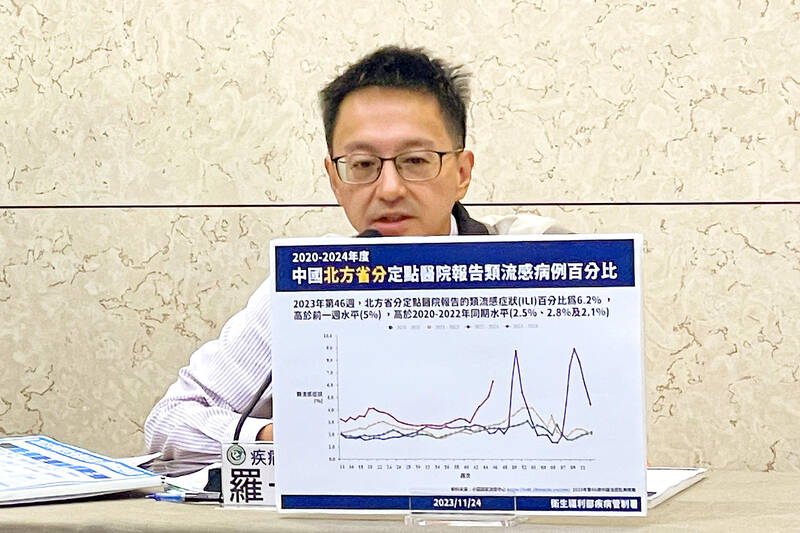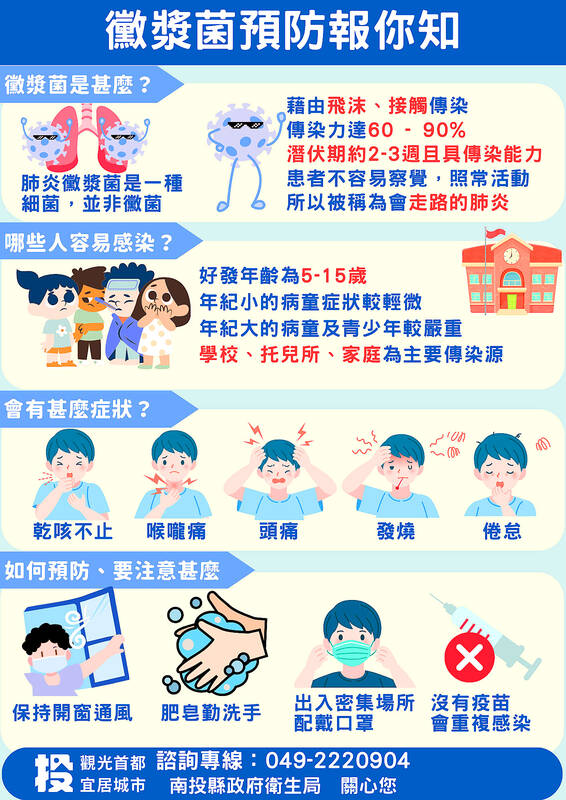A request by the World Health Organization (WHO) for more information on a surge in respiratory illnesses and clusters of pneumonia in children in China has attracted global attention.
Health authorities have not detected any unusual or novel pathogens, the WHO later said, and doctors and public health researchers say there is no reason for international alarm.
Authorities in Taiwan, however, last week advised the elderly, very young and those with poor immunity to avoid travel to China.

Photo: Chiu Chih-jou, Liberty Times 照片:自由時報記者邱芷柔
The following is what we know about the surge in illness in the world’s second most populous country so far, and why experts think there is no need to panic.
WHAT IS HAPPENING ON THE GROUND?
The rise in respiratory illnesses comes as China braces for its first full winter season since it lifted strict COVID-19 restrictions in December last year.

Photo courtesy of Nantou County Government’s Public Health Bureau 照片:南投縣衛生局提供
The spike in illness came into the spotlight when the WHO asked China for more information on Nov. 22, citing a report by the Program for Monitoring Emerging Diseases (ProMED) on clusters of undiagnosed pneumonia in children.
Some social media users have also posted photographs of children receiving intravenous drips in hospital, while media in cities such as Xian in the northwest have posted videos of crowded hospitals, fanning concerns of potential strains on the healthcare system.
HOW BIG IS THE SURGE?
China’s National Health Commission told a news conference on Nov. 13 that there was an increase in incidence of respiratory disease, without providing further details.
WHO China told Reuters in an email that “Chinese health authorities advised that the current numbers they are observing is not greater than the peak in the most recent cold season prior to the COVID-19 pandemic.”
WHAT PATHOGENS ARE CIRCULATING?
The data suggests the increase is linked to the lifting of COVID-19 restrictions along with the circulation of known pathogens such as mycoplasma pneumoniae, a common bacterial infection that typically affects younger children and which has circulated since May.
Influenza, respiratory syncytial virus (RSV) and adenovirus have been in circulation since October.
IS MYCOPLASMA PNEUMONIAE A MAJOR CONCERN?
One concern about the surge in respiratory illness is mycoplasma pneumoniae, which has also spiked in other countries.
Maria Van Kerkhove, COVID-19 Technical Lead at the WHO told reporters on Wednesday last week that mycoplasma pneumonia is not a reportable disease to the WHO, and it was on the rise for the last couple of months but now appears to be declining.
“We’re following up through our clinical networks and working with clinicians in China to better understand resistance to antibiotics, which is a problem across the world, but is a particular problem in the Western Pacific and South East Asia region,” she said.
Rajib Dasgupta, an epidemiologist and professor of community health at Jawaharlal Nehru University in New Delhi, told Reuters in some cases there may be serious complications from infection caused by mycoplasma pneumoniae, but most people will recover without antibiotics.
WHY AREN’T EXPERTS CONCERNED?
Doctors in China and experts abroad are not too worried about the situation in China, noting many other countries saw similar increases in respiratory diseases after easing pandemic measures.
“The cases that we are seeing is nothing unusual at the moment, because it’s still the same cough, colds, fever presentation, and the good thing about it is that it’s actually treatable,” said Cecille Brion, head of the pediatrics department at Raffles Medical Group Beijing.
Van Kerkhove said that the rise in cases was expected.
“We are seeing, in general, an increase in respiratory infections around the world. We do tend to see increases in children because they’re the school-aged children, and in the northern hemisphere it’s the autumn already. We’re entering the winter months,” she said.
(Reuters)
呼吸道疾病與兒童群聚肺炎病例在中國激增,世界衛生組織要求提供更多相關資訊,這引起了全球關注。
世衛組織隨後表示,衛生當局尚未發現任何不尋常或新的病原體,醫師與公共衛生研究人員表示,並無證據顯示需發出國際警示。
然而,台灣當局上週建議長者、幼兒及免疫力差的人避免前往中國。
人口世界第二多之國家中國病例激增,以下是我們迄今之了解,以及專家認為無需恐慌之原因。
當地發生了什麼事?
呼吸道疾病的增加,正值中國準備迎接自去年12月取消嚴格的COVID-19封鎖措施以來第一個完整冬季。
世界衛生組織11月22日援引新興疾病監測計畫(ProMED)有關兒童群聚感染未知肺炎的報告,要求中國提供更多訊息,因而使病例激增成為關注焦點。
一些社群媒體用戶還貼出兒童在醫院接受靜脈點滴注射的照片,而中國西北西安等城市的媒體則發布了醫院人滿為患的影片,引發人們擔憂醫療保健系統可能會無法承受壓力。
病例激增幅度有多大?
中國國家衛生健康委員會在11月13日的記者會中表示,呼吸道疾病發生率有所上升,但未提供進一步細節。
世衛組織駐中國代表處以電子郵件告訴路透,「中國衛生當局表示,他們目前觀察到的數目,並不比COVID-19疫情前最近一個寒冷季節的高峰多」。
有哪些病原體正在傳播?
數據顯示,病例增加與 COVID-19 解封及肺炎黴漿菌等已知病原體的傳播有關,肺炎黴漿菌是一種常見的細菌感染,通常影響年幼的兒童,自五月以來一直在傳播。
流感、呼吸道融合病毒(RSV)和腺病毒自十月以來也一直在傳播。
肺炎黴漿菌是個大問題嗎?
呼吸道疾病激增的一個重要因素是肺炎黴漿菌,在其他國家病例也激增。
世界衛生組織 COVID-19 技術負責人瑪麗亞.范科霍芙上週三告訴記者,肺炎黴漿菌不是應向世衛報告的疾病,過去幾個月它的發病率呈上升趨勢,但現在似乎正在下降。
她說:「我們正在透過臨床網路進行追蹤,並與中國的臨床醫師合作,以便更能了解對抗生素的抗藥性,這在世界各地都是個問題,但在西太平洋和東南亞地區情況尤為特別」。
新德里賈瓦哈拉爾.尼赫魯大學流行病學家兼社區衛生教授拉吉布.達斯古普塔告訴路透,在某些情況下,肺炎黴漿菌感染可能會出現嚴重的併發症,但大多數人無需抗生素即可康復。
為何專家不擔心?
中國的醫師與國外專家對中國的情況並不太擔心,他們指出,在防疫措施鬆綁後,許多其他國家的呼吸道疾病也出現了類似的增加。
北京萊佛士醫院兒科主任賽西兒‧布里恩表示:「目前我們看到的病例並不罕見,因為仍是同樣的咳嗽、感冒、發燒症狀,好處是它其實是可以治療的」。
范科霍芙表示,病例增加是預料之中的。
「總體而言,我們看到世界各地呼吸道感染有所增加。兒童病例確實有增加的傾向,因為他們是學齡兒童,在北半球已是秋天了。我們正進入冬天」,她說。
(台北時報林俐凱編譯)

In an effort to fight phone scams, British mobile phone company O2 has introduced Daisy, an AI designed to engage phone con artists in time-wasting conversations. Daisy is portrayed as a kindly British granny, exploiting scammers’ tendency to target the elderly. Her voice, based on a real grandmother’s for authenticity, adds to her credibility in the role. “O2” has distributed several dedicated phone numbers online to direct scammers to Daisy instead of actual customers. When Daisy receives a call, she translates the scammers’ spoken words into text and then responds to them accordingly through a text-to-speech system. Remarkably, Daisy

Bilingual Story is a fictionalized account. 雙語故事部分內容純屬虛構。 Emma had reviewed 41 resumes that morning. While the ATS screened out 288 unqualified, she screened for AI slop. She could spot it a mile away. She muttered AI buzzwords like curses under her breath. “Team player.” “Results-driven.” “Stakeholder alignment.” “Leveraging core competencies.” Each resume reeked of AI modeling: a cemetery of cliches, tombstones of personality. AI wasn’t just changing hiring. It was draining the humanity from it. Then she found it: a plain PDF cover letter. No template. No design flourishes. The first line read: “I once tried to automate my

Every May 1, Hawaii comes alive with Lei Day, a festival celebrating the rich culture and spirit of the islands. Initiated in 1927 by the poet Don Blanding, Lei Day began as a tribute to the Hawaiian custom of making and wearing leis. The idea was quickly adopted and officially recognized as a holiday in 1929, and leis have since become a symbol of local pride and cultural preservation. In Hawaiian culture, leis are more than decorative garlands made from flowers, shells or feathers. For Hawaiians, giving a lei is as natural as saying “aloha.” It shows love and

1. 他走出門,左右看一下,就過了馬路。 ˇ He walked outside, looked left and right, and crossed the road. χ He walked outside and looked left and right, crossed the road. 註︰並列連接詞 and 在這句中連接三個述語。一般的結構是 x, y, and z。x and y and z 是加強語氣的結構,x and y, z 則不可以。 2. 他們知道自己的弱點以及如何趕上其他競爭者。 ˇ They saw where their weak points lay and how they could catch up with the other competitors. χ They saw where their weak points lay and how to catch up with the other competitors. 註:and 一般連接同等成分,結構相等的單詞、片語或子句。誤句中 and 的前面是子句,後面是不定詞片語,不能用 and 連接,必須把不定詞片語改為子句,and 前後的結構才相等。 3. 她坐上計程車,直接到機場。 ˇ She took a cab, which took her straight to the airport. ˇ She took a cab and it took her straight